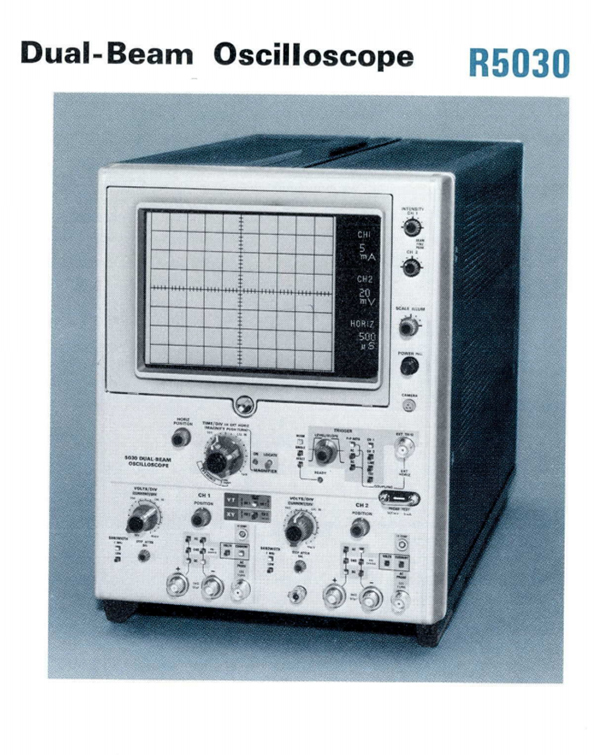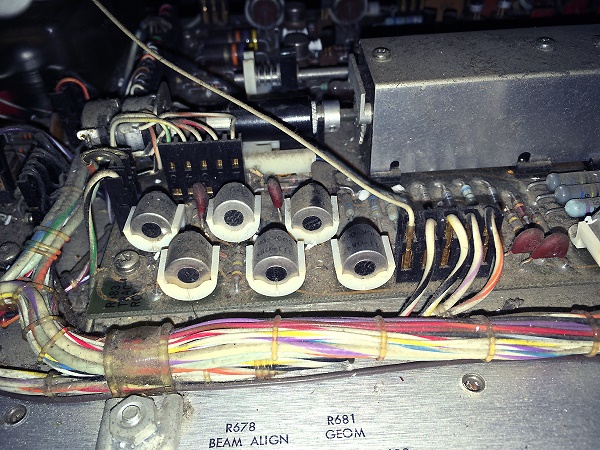Tektronix 5030 Oscilloscope
A very unusual oscilloscope
I want to edit this page, as things develop. On the one hand for people who are interested in such an oscilloscope, on the other hand just to document here, how such a project can develop.
My interest in Tektronix Devices was triggered during my studies, where we had a Tektronix Current Probe in the "Energy Lab", coupled to a Philips Oscilloscope of the PM series, and I noticed this balance between excellent specifications, and not overdoing it. In my later R&D job, we also had a huge 100mHz Tektronix Scope on a cart, with Delayed sweep and a storage tube. This opened my eyes for what a company like Tektronix was able to build.
When I started my own company I simply needed a current probe, and noticed there is only crap on the market, or these old Tektronix current probes from the 1970's with much better specifications. So I decided to restore some. Yet the large size electronics modules you need along with those, doesn't make them very comfortable to use. Later I found out, Tektronix build a scope with two differential inputs, and two current probe inputs. So six inputs in one monolythic chassis. Attached to a real dual beam CRT. These were the 5030 and 5031, which difference is, 5031 has a storage tube. I prefer the 5030, because the none storage tube has a sharper picture, which is another reason why I LOVE these old CRT scopes.  Specifications
Specifications
- Dual Beam.
- Bandwidth DC to 1 MHz (5 kHz limit switchable)
- Deflection 10 μV/Div to 10 V/Div or 1 mA/Div to 200 mA/Div
- Noise < 15 μV / 200 μA.
- Input impedance 1 MΩ // 50 pF
- Time base 1 μs/Div to 5 s/Div
- Magnifier × 1, 2, 5, 10, 20, 50 (1 μs/Div max.)
The meaning of 10uV/Div sensitivity.
This is really extremely small signal. Now it is misleading a little bit, because to display a signal of 5 Divisions, you need 50uV signal, and it's a matter of design how large your divisions are. WIth the 5030, the divisions are 2x larger as with small CRT scopes. But still a signal of 10uV will be not very nice to look at, and suffering from noise too. However this is so with any oscilloscope, and comparing this with a 1mV/Div scope, we have already 100x more sensitivity here, and most standard scopes have 5mV/Div anyway. So this is just to put 10uV/Div in the right perspective
Differential Inputs
If you ever tried to do a measurement on signal hum with audio amplifiers, you sure will have noticed even a 5mV/Div input displays a lot of hum mess, and the measurement is useless. working. You can sure measure 1kHz signals of 5mV/Div, but at 50Hz, you catch so much hum "over the air" or via your fingers, that a measurement gets totally obstructed by that. At least that is what I thought myself, and I have to admit, I thought so for decades. Until... I used a differential scope (HP130) for the first time, and then I began doing this the right way. Now I am SURE this is in every school book, but I seem to have missed it ever since, and perhaps I am not the only one. So I write it here, for in case you are interested.
What you need to do first, is set up a differential measurement, with two probe inputs. This is a bit difficult to set up with a normal scope, and it's quite a practice, but when you have it working, the scope should displace the difference between the two probe tips. When you have such adapters from BNC to banana, use these, and plug in the probe wires from a multimeter. You will be surprized how well this WORKS. There will be no hum, and shielded cable is not needed any more. But you may as well work with two normal coaxial cable probes. However when measuring on audio equipment, the coaxial cables function only as shield, and are not needed at all for their better high frequency properties, in the MHz range. So for a differential measurement, unshielded probe wires with banana plugs are fine. I find this very convenient myself. At HP, when designing the HP130 differential (audio) scope, they used banana inputs for that reason straight away. It doesn't even have coaxial inputs. Why should it?!
For a differential measurement of hum on low signal, what you need to do, connect one of the two probe tips to GROUND of the object you are measuring on. Use the other probe to do the measurements. If you do that, by MAGIC, the hum you picked up over the air, or by touching some cables, or by the way the mains cables are laid, or these "hand" effects... All of that is gone! Once I saw this, I wanted a scope with real differential inputs. So I do not have to re-adjust the scope every time I switch the gain. Also, since a differential input is much more less susceptible to external hum, it is only logical, sensitivity of such inputs can be higher by the design. For my old HP130 oscilloscope it is 200uV/Div. Some of the input modules of Tektronix scopes go down to 20uV/Div, but they do so at 10x more noise. So effectively they are better than the HP130. My hope is now, this dedicated 10uV/Div scope 5030 will do a better job than those modular products.
Some history.
I know little about this, and what I write here was just picked up. 5030 and 5031 were not a commercially success. This has to do with the users not being of how these units can work. This a really good example of a technical perfect product, which did not make it, because the users do not understand the advantage of it. They were in the catalog only from 1969 to 1971, and were replaced then by the modular series of 7000 scopes. The advantage I keep on seeing with 5030/5031, is the vertical amplifiers are nicely constructed in a shielded case, which you can open from the bottom, and work in it conveniently. It's not really miniaturized. Unlike the 7000 series modules, on which you can not work electrically, since they need to be plugged in for that.
Where to find one?
That was very difficult. On Ebay was one for sale, which look like stored in an old barn for the last 15 years, and they wanted 500$ for it. I had two adds in the internet, and a person from Paris had one for sale, but he refused to send it by post. Then out of nothing, half a year later I received an offer from a gentleman from Glasgow, to pick one up for free. He agreed I could send Fedex to pick it up, and that worked out all fine.
This seems like a promising project, as it was working when he stored it, a long time ago, but now the CRT produces only a dot. This picture he send me:

After looking inside, I was surprized about the great amount of dust which had collected, and I want to clean that first before switching it on again. Some drops of liquid must have fallen inside as well, and it produced some grey-white oxide stains on the aluminum of the inside metals. So whatever that was, I want to clean this off the PCBs first, before switching it on.

WILL BE CONTINUED